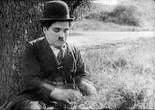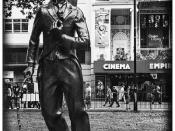Charlie Chaplin'sCity Lights, subtitled "A Comedy Romance in Pantomime," was released in 1931. Chaplin was responsible for the film's production, direction, editing, music, and screenplay. City Lights is a combination of pathos (an emotion of sympathetic pity), slapstick and comedy. In the film City Lights Chaplin uses pathos in the scenes "Flower Girl", "This Time Stay Out" and "Still Hoping".
The first example of pathos in City Lights is in the scene "the Flower Girl." In this scene he enters and exits a parked limousine in a traffic jam to avoid a motorcycle policeman where he then confronts a beautiful blind girl selling flowers. She hears the limo door slam and assumes he is a millionaire. She asks him to buy a flower; he is infatuated with her and gives her his last coin for a flower. She then thinks he has left because she hears another limo door slam.
Without asking for his change, he sits silently on the bench and watches her adoringly. While she changes the water for her flowers at the fountain, she accidentally throws a bucket of dirty water in his face. When the Flower Girl goes home that evening she dreams of more visits from him.
The next example of pathos is in the scene "This Time, Stay Out." During this scene the little tramp goes to the millionaire's mansion in the limo the millionaire gave him when he was drunk, but the millionaire has sobered up, and doesn't remember the little tramp and wants nothing to do with him. The Tramp is forced out of the house by the butler at the front door and walks away disappointed. Then, in the millionaire's limo, he trails a man down the street waiting for him to throw out his cigarette. He has to...


